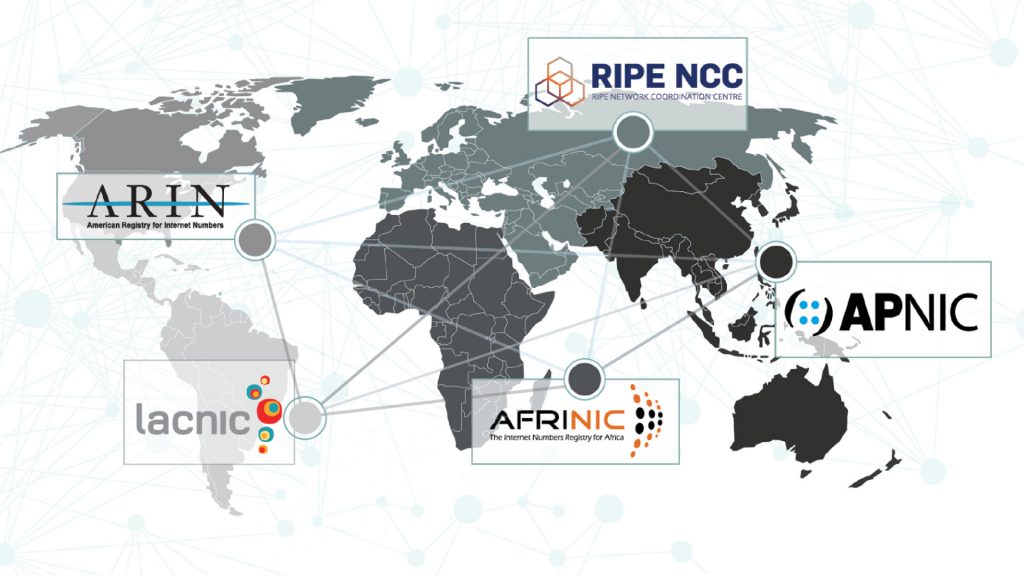Buying and Selling IPv4
Between RIRs
by IPv4.Global Staff

Anyone buying or selling IPv4 address space has a bigger market when they consider an inter-region transfer. It has been exercised enough that there are strong processes in place. An inter-region transfer is very similar to an intra-region transfer.
In fact, there were about 2,000 IPv4 transfers in the European region in 2022. But since inter-region transfers became possible, companies in the region have transferred 756 blocks originating in other regions. And they have transferred 350 blocks out to companies in other regions. Inter-region transfers aren’t the majority of the market but they are a significant part of it.
That’s because of the distribution of IPv4 address space. ARIN, the registry for North America, manages about 100 /8s of IPv4 space. The registries for the Asia Pacific and Europe manage 53 and 50 respectively. Nine more /8s are managed by the registries for Africa and Latin America.
Some people might hesitate to involve a second registry in their transfer transaction. But with years of experience, these processes are now mature and efficient.
The Regional Internet Registries
There are five Regional Internet Registries (RIRs). They manage, distribute, and register IPv4 and IPv6 addresses and Autonomous System Numbers in their regions. Each region is roughly continental.
The IP addresses you use are registered in an RIR database. A transfer happens when the registration is updated to reflect a new owner for the block – or when the block moves from one RIR’s database to another. So the RIR must manage the transfer process.
Their policies are decided by their communities. Anyone with an interest can participate in RIR policy development, which happens on email discussion lists and at public meetings. The five policies are broadly similar with regional variations.

Fig 1: The geographic boundaries of the five RIRs
| RIR | Full name, geographic scope, and membership size |
| AFRINIC | The African Network Coordination Centre was established in 2005, is based in Mauritius and serves Africa. It has over 2,000 members. |
| APNIC | The Asia-Pacific Network Coordination Centre was established in 1993, is based in Australia and serves the Asia Pacific. It has almost 24,000 members. |
| ARIN | The American Registry for Internet Numbers was established in 1997, is based in the USA and serves the United States, Canada, many Caribbean and North Atlantic islands. It has over 17,000 members and over 15,000 organizations that got addresses before ARIN was formed. |
| LACNIC | The Latin American and Caribbean Internet Addresses Registry was established in 2002, is based in Uruguay and serves Latin America and the Caribbean. It has over 12,000 members. |
| RIPE NCC | Réseaux IP Européens Network Coordination Centre was established in 1992, is based in the Netherlands and serves Europe, the Middle East and parts of Central Asia. It has over 23,000 members. |
The RIRs are all operationally and financially independent. But they cooperate on shared activities that serve their common stakeholders through the Number Resource Organization.
It was established in 2003 and its mission is to contribute to an open, stable and secure Internet, through:
- Providing and promoting a coordinated Internet number registry system.
- Being an authoritative voice on the multi-stakeholder model and bottom-up policy process in Internet governance.
- Coordinating and supporting joint activities of the RIRs
Inter-RIR transfers are an example of this. Its engineering teams have coordinated to ensure that a registration is removed from one database when it is added to another. This is vital to avoid confusion over which organization is responsible for an address block. This is often referred to as “uniqueness.”
Registration Accuracy
All five RIRs give the accuracy of registration data a top priority. In the 1990s and early 2000s they focused on ensuring that organizations did not get more space than they could justify under the policies. Now that their IPv4 pools are empty they make sure they have accurate information for the organizations behind the addresses in their registries.
The RIRs’ Know Your Customer checks protect everyone. The RIRs won’t let a transfer go ahead unless they can tie the addresses to the organization selling them.
In contrast, industry blogs often report court cases about domain names that might have been stolen being sold in that secondary market.
Mature Processes
Inter-RIR transfer policies were developed about 10 years ago. The policies and the processes to implement them have been refined since then.
APNIC, ARIN, and the RIPE NCC all have mature inter-RIR transfer processes and they are reciprocal. This means that the recipient of the transferred addresses must demonstrate that they need them. The criteria for the need are the same as if it were an allocation from the RIR.
One example of the maturity of these processes is that live, routed addresses can be transferred without an interruption to service. APNIC staff reported this in the informal RPKI Discord community in September 2023. This means that behind the scenes things, like IRR and RPKI entries must be coordinated.
LACNIC and AFRINIC
Organizations based in the AFRINIC region can transfer addresses between each other, but not to or from organizations in other regions. There have been proposals to revise that policy, but the organization has not been able to hold a policy meeting or make progress on policy development for a few years.
LACNIC implemented a policy allowing inter-RIR transfers in July 2020 but not many had been completed by mid-2023. LACNIC was the source of 20 transfers and the recipient of 28.
Transactions involving LACNIC typically take several months and require a wet ink signature. This means moving a paper document around the world. It can take several days or weeks to get responses for LACNIC transfer tickets. This longer process often drives a lower price for IP address transactions involving LACNIC.
Common Process Elements
While the policies and supporting processes vary between the RIRs, they are reciprocal. This means the main differences buyers and sellers will experience are the forms they complete.
Custodianship or Ownership
The origin RIR will make sure the organization transferring the addresses away has that right. When the RIR allocated those addresses itself this is easy. When the addresses were allocated by someone else – another RIR or a pre-RIR registry – they will check the chain of custody. In some cases this is simple. For instance, educational institutions are less likely to be involved in mergers and acquisitions. But commercial organizations often are.
The RIR will check that the block of addresses being transferred is properly controlled by the organization selling them. Sometimes this involves checking company registry information and looking at other sources.
The RIRs want to avoid transferring resources when there is any dispute as to their status.
Justification
The recipient of the transfer will be subject to a “needs based assessment” by the receiving RIR as that is where the addresses will then be registered. This assessment will check that the buyer intends to use the addresses on an operational network. It will also look at how quickly and how efficiently the addresses will be used. IPv4.Global has experts who can advise on how to design and document an addressing plan.
Payment
Each RIR manages its own fee schedule. Some have specific transfer related fees. APNIC and ARIN require their fees to be paid in advance. LACNIC’s fees are paid in installments.
| RIR | Fees and payment requirements |
| APNIC | For intra-APNIC transfers, the buyer pays fees. For inter-RIR fees, the seller pays fees. If both members are APNIC, only the buyer pays. The fee is calculated by taking 20% of the annual fee (membership) for the number of IPv4 addresses being transferred in a single transfer request. APNIC’s fees are denominated in AUD. |
| ARIN | The seller pays ARIN $500 and the buyer pays a fee based on the size of the address block. |
| LACNIC | A $200 initial payment is required to open a ticket. Sellers usually open this ticket, and Buyers are then expected to pay the remaining fee. The remaining fee is $1,000 for blocks smaller than /19 and $1,500 for /19 and larger blocks. |
| RIPE NCC | There are no transfer fees, but the seller must have paid its membership fee. |
Fee Calculator
IPv4.Global has developed a tool for calculating transfer fees at the four RIRs that permit transfers between registries. Of course, this tool works for intra-RIR transfers as well. It can be found here: Transfer Fee Calculator.
Hold Periods
The RIRs want IPv4 addresses to be used on networks. They don’t want them to become an investment vehicle.
| RIR | Limitations |
| APNIC | Allocations from 103.0.0.0/8 must be held for five years before being transferred. There is no hold period for transfers from other blocks. |
| ARIN | ARIN requires addresses to be held for five years after being issued from the waitlist, or 12 months for other space. The hold does not apply to addresses acquired through mergers and acquisitions. |
| LACNIC | Transferred addresses must be held for a year before being transferred again |
| RIPE NCC | IPv4 addresses must be held for two years before being transferred, including addresses acquired through M&A. The hold does not apply for legacy addresses if treated as a legacy update. |
Your To-Do List
You can buy or sell IPv4 addresses in the larger inter-RIR transfer market in just five steps. Of course, you might have particular needs. We can help you with them and provide help beyond these five process steps.
- Addressing Plan: Buyers need to know how many IPv4 addresses they need. An addressing plan shows you how you’ll use addresses across your network and the total number of addresses you’ll need.
- Pre-approval: inter-RIR transfers are needs based. The buyer needs their RIR to confirm that they have a need for the addresses they are buying.
- Negotiation: Buyers and sellers need to find each other. Our auction platform is the most transparent way of doing this. We can also help buyers and sellers negotiate private sales on request.
- Transfer request: The seller asks their RIR for a transfer. When the transfer is approved the seller’s RIR will contact the buyer’s RIR.
- Complete the transfer: Both the seller and buyer agree to the transfer and the RIRs update the database records.
Next Steps
Inter-RIR transfers offer a larger market for buyers and sellers. As a Qualified Facilitator, IPv4.Global can smooth your journey through the process. We have brokered over $1 billion of sales and can help buyers and sellers complete their transaction.
Call us on +1-212-610-5601 or write to info@ipv4.global. We can help you achieve your business objectives.